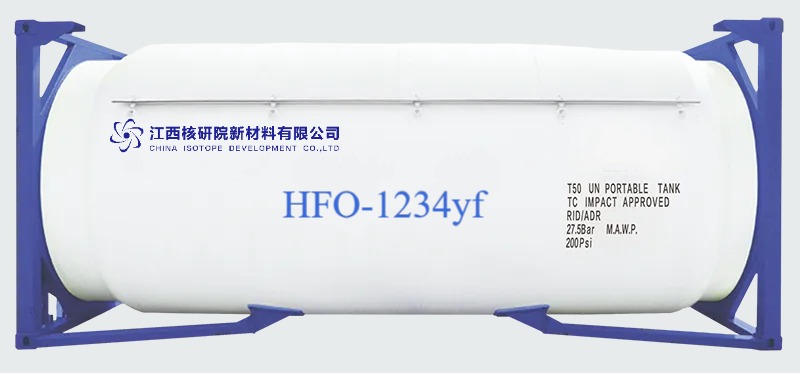High-Efficiency and Low-Impact: Why HFO 1234yf Refrigerant is Defining the Future of Sustainable Mobility
By Tao, Published Oct .1, 2025
As a senior researcher with decades of specialization in specialty gases—including fluorocarbon chemistry and environmental compliance—I have tracked the arduous but necessary evolution of refrigeration technologies. The transition away from high-Global Warming Potential (GWP) hydrofluorocarbons (HFCs) is one of the most significant challenges facing the automotive and climate sectors. At the center of this transformation lies HFO 1234yf, a molecule that represents not just a regulatory fix but a fundamental shift towards sustainable, high-performance thermal management. This article examines the critical significance of HFO 1234yf, detailing its scientific advantages, regulatory compliance mechanisms, and pivotal role in global decarbonization efforts.
The Trajectory of Refrigerants: A Regulatory Overview
The history of refrigerants is intrinsically linked to global environmental policy, evolving through four distinct chemical generations, each defined by its impact on the ozone layer (Ozone Depletion Potential, ODP) and global warming (GWP). Understanding this trajectory is crucial to appreciating the necessity of HFO 1234yf [1].
1. First Generation: Chlorofluorocarbons (CFCs)
Products: R-12, R-11.
Environmental Impact: High ODP and high GWP.
Status: Globally phased out under the Montreal Protocol (1987) due to catastrophic ozone damage.
2. Second Generation: Hydrochlorofluorocarbons (HCFCs)
Products: R-22, R-123.
Environmental Impact: Lower ODP than CFCs, but still significant, alongside moderate GWP.
Status: Phased out in developed nations (EU, US) and currently undergoing mandatory global phase-down under accelerated provisions of the Montreal Protocol [2].
3. Third Generation: Hydrofluorocarbons (HFCs)
Products: R-134a, R-410A.
Environmental Impact: Zero ODP, but extremely high GWP (e.g., R-134a has a GWP of 1430).
Status: Currently the dominant technology but subject to a global phase-down under the Kigali Amendment (2019) and regional legislation like the EU F-Gas Regulation, due to their potent greenhouse effect [3].
4. Fourth Generation: Hydrofluoroolefins (HFOs)
Products: HFO-1234yf, HFO-1234ze.
Environmental Impact: Zero ODP and ultra-low GWP (typically GWP < 5).
Status: Represents the current global standard for new mobile air conditioning (MAC) systems and is increasingly adopted in commercial refrigeration.
HFO 1234yf: The Chemistry of Rapid Decay
HFO 1234yf (2,3,3,3-Tetrafluoropropene, chemical formula: CH₂=CFCF₃) is an olefin—a molecule containing a carbon-carbon double bond. This double bond is the key structural feature responsible for its excellent environmental profile [4].
Molecular Mechanism of Low GWP:
Unlike HFCs, which are fully saturated (single bonds only) and highly stable, the C=C double bond in HFO 1234yf makes the molecule highly susceptible to attack by hydroxyl radicals (•OH) naturally present in the atmosphere. This reaction rapidly breaks down the molecule into benign substances, such as trifluoroacetic acid (TFA), which quickly precipitate out of the atmosphere [5].
This process ensures an atmospheric lifetime of only 11 days, compared to the 13 years required for R-134a to break down. This rapid decay translates directly into a GWP of just 4, which is 99.7% lower than R-134a (GWP 1430). This difference is the fundamental driver behind its significance, making it a viable, long-term, low-GWP solution [6].

HFO-1234yf
Core Significance I: Achieving Environmental Compliance
The primary significance of HFO 1234yf is its ability to facilitate compliance with stringent international climate regulations aimed at mitigating the warming impact of fluorinated gases.
The EU F-Gas Mandate:
The transition to HFO 1234yf was accelerated by the European Union’s Mobile Air Conditioning (MAC) Directive, which mandated that all new vehicle types introduced since January 1, 2017, must use refrigerants with a GWP below 150 [7]. Since R-134a (GWP 1430) was prohibited, HFO 1234yf became the industry’s favored replacement, ensuring the EU automotive market immediately decoupled refrigerant use from high-GWP emissions.
Global Impact via the Kigali Amendment:
The global mandate to phase down HFCs under the Kigali Amendment has made HFO 1234yf a global standard, reducing the greenhouse gas impact equivalent to removing millions of older vehicles from the road annually. Furthermore, legislative moves in the US, such as the EPA’s Significant New Alternatives Policy (SNAP) and the American Innovation and Manufacturing (AIM) Act, have positioned HFO 1234yf as the primary accepted alternative for R-134a in MAC systems across North America [8].
Core Significance II: Engineering Performance and Economic Efficiency
While environmental performance is crucial, wide-scale adoption hinges on technical viability and economic feasibility. HFO 1234yf excels by offering thermodynamic characteristics highly comparable to R-134a, minimizing the need for radical system redesign.
Performance Characteristics:
HFO 1234yf maintains similar cooling capacity and Coefficient of Performance (COP) to R-134a across typical operating conditions [9]. This parity is essential, as it prevents performance degradation in end-user applications. Furthermore, its higher vapor density allows engineers to utilize slightly smaller compressors, potentially optimizing system design, reducing overall vehicle weight, and contributing incrementally to fuel economy (lowering emissions by 20% to 30% compared to high-pressure CO₂ systems) [10].
Economic Rationality: Low Conversion Cost:
The most compelling economic advantage for Original Equipment Manufacturers (OEMs) lies in the system compatibility. HFO 1234yf can be integrated into existing R-134a automotive air conditioning system designs (compressors, condensers, evaporators) with only minor modifications, such as the implementation of leak-prevention seals and specialized service ports [11].
- Manufacturing Protection: This minimizes capital expenditure on new assembly lines. Global automotive air conditioning compressor manufacturers prefer HFO 1234yf because developing compressors for this working fluid is significantly less challenging and allows for high utilization of existing manufacturing equipment, protecting invested resources [12].
- Unified Global Solution: HFO 1234yf offers a single, globally compliant solution. This simplifies supply chain management for international automakers, who can standardize their MAC systems worldwide, reducing complexity and long-term operating costs [13].
Navigating Safety and Flammability Concerns
The introduction of HFO 1234yf was met with initial controversy regarding its flammability—a key consideration in automotive safety, particularly after collisions.
Classification and Scientific Validation:
The American Society of Heating, Refrigerating and Air-Conditioning Engineers (ASHRAE) classifies HFO 1234yf as an A2L refrigerant. This designation signifies it has low toxicity (A) and is mildly flammable (2L) [14]. Critically, the “L” denotes a low burning velocity (<10 cm/s), meaning it is difficult to ignite and burns slowly if ignition occurs.
Rigorous, multi-year testing by independent third-party organizations, including the Society of Automotive Engineers (SAE) Cooperative Research Program (CRP), concluded that HFO 1234yf does not pose a significant safety risk in MAC systems, even under severe crash conditions [15]. The conditions required for ignition (high energy source, specific concentration, and airflow) are extremely rare within the sealed automotive environment. The consensus is that using HFO 1234yf in vehicles is comparable in safety to using the legacy R-134a [16].
Future Outlook and Market Expansion
While HFO 1234yf has firmly established itself in the global light vehicle market, its adoption is now expanding into new sectors driven by policy and performance mandates.
Commercial and Heavy-Duty Vehicles (HDV):
The next frontier for HFO 1234yf is the medium- and heavy-duty commercial vehicle market, as well as off-road equipment (construction, agricultural machinery) [17]. The regulatory environment, particularly the US AIM Act, is increasingly pushing HDV OEMs to phase down R-134a. HFO 1234yf is positioned as the ideal solution due to its proven performance under demanding conditions and minimal retrofit requirements for large-scale systems [18].
Addressing the Cost Barrier:
Currently, the most persistent challenge to widespread adoption, especially in cost-sensitive developing economies, remains the high initial cost of the HFO 1234yf gas itself, which is significantly higher than R-134a [19]. However, this cost barrier is expected to diminish as global production capacity increases, supply chains mature, and technological advancements streamline the manufacturing of the complex hydrofluoroolefin molecule [20].
Conclusion: A Cornerstone of Sustainable Cooling
HFO 1234yf is more than just a temporary replacement; it represents a major milestone in fluorocarbon gas technology, successfully balancing the stringent demands of environmental stewardship with the economic and engineering realities of the global automotive industry. Its ultra-low GWP and comparable thermal performance have made it the cornerstone solution for complying with global phase-down initiatives like the Kigali Amendment. As manufacturers continue to prioritize sustainable mobility, HFO 1234yf will continue to expand its influence, ensuring that cooling technology contributes to, rather than detracts from, global climate goals.
Would you like a deeper dive into any specific technical parameters or applications?
(Follow up our update articles on www.asiaisotopeintl.com or send your comments to tao.hu@asiaisotope.com for further communications)
Reference
- United Nations Environment Programme (UNEP). (2022). The Montreal Protocol: An Overview. https://ozone.unep.org
- U.S. Environmental Protection Agency (EPA). (2023). Phaseout of Ozone-Depleting Substances. https://www.epa.gov
- European Union. (2014). Regulation (EU) No 517/2014 on fluorinated greenhouse gases (F-Gas Regulation). https://eur-lex.europa.eu
- DuPont/Chemours Technical Report. (2020). Properties and Performance of HFO-1234yf. https://www.chemours.com
- Journal of Atmospheric Chemistry and Physics. (2019). Atmospheric Fate of HFO Refrigerants. https://www.atmos-chem-phys.net
- IPCC Fifth Assessment Report (AR5). (2014). GWP Values for Refrigerants. https://www.ipcc.ch
- European Union. (2006). Directive 2006/40/EC relating to emissions from air-conditioning systems in motor vehicles. https://eur-lex.europa.eu
- U.S. Environmental Protection Agency (EPA). (2023). AIM Act and HFC Phasedown. https://www.epa.gov
- SAE International J2842. (2021). R-1234yf System Performance and Service Practices. https://www.sae.org
- International Journal of Refrigeration. (2020). Thermodynamic Comparison of R-1234yf and R-134a. https://www.sciencedirect.com
- VDA (German Association of the Automotive Industry) Position Paper. (2017). HFO-1234yf Implementation. https://www.vda.de
- Automotive News. (2022). OEM Shift to Low-GWP Refrigerants. https://www.autonews.com
- Global Supply Chain Management Review. (2021). Standardization Benefits of HFO-1234yf. https://gscm.us
- ASHRAE Standard 34. (2019). Designation and Safety Classification of Refrigerants. https://www.ashrae.org
- SAE International CRP1234. (2018). Safety Assessment of HFO-1234yf in Mobile Air Conditioning. https://www.sae.org
- National Highway Traffic Safety Administration (NHTSA). (2016). Evaluation of Flammability Characteristics of R-1234yf. https://www.nhtsa.gov
- Cooling Post. (2023). Expansion of R1234yf into Commercial Vehicle Sector. https://www.coolingpost.com
- Mobile Air Conditioning Society (MACS) Worldwide. (2022). Future of Refrigerants in Heavy-Duty Vehicles. https://www.macsw.org
- Market Analysis Report. (2023). Global Refrigerant Pricing Trends. https://www.grandviewresearch.com
- Chemical Engineering News. (2021). Manufacturing Advances in HFO Production. https://cen.acs.org





